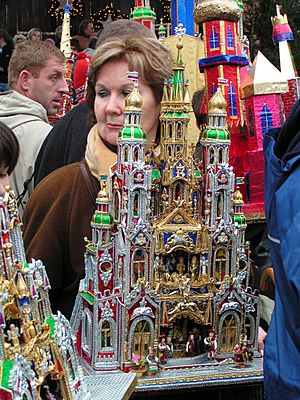Kraków szopka facts for kids
|
UNESCO Intangible Cultural Heritage
|
|

Kraków szopka by Bronisław Pięcik at the Krzysztofory Museum, Kraków Main Square
|
|
| Country | Poland |
|---|---|
| Domains | Architecture, Effigies, Religious practice |
| Reference | 1362 |
| Region | Europe and North America |
Quick facts for kids Inscription history |
|
| Inscription | 2018 (13 session) |
| List | Representative |
Kraków szopki (pronounced shohp-kee) are special nativity scenes from Kraków, Poland. They are a unique Christmas tradition that started in the 1800s. What makes them so special is that they use famous buildings from Kraków as the background for the story of Jesus's birth.
In 2018, these amazing szopki were added to the UNESCO list of Intangible Cultural Heritage of Humanity. This means they are recognized as an important part of human culture.
Contents
What Are Szopki?
Szopki are beautiful, often very tall, models of nativity scenes. They are usually made from light materials like cardboard and colorful foil. These models are inspired by the historic buildings of Kraków.
You might see famous places like St. Mary's Basilica, Kraków or Wawel Castle in a szopka. The scene of Jesus's birth is often shown on an upper floor. The lower parts might feature historical figures or Polish legends.
The History of Szopki
Nativity scenes have been part of Christian culture for a long time. They began with Saint Francis of Assisi in the 1200s. Soon, they became popular in Poland too.
During the Middle Ages, a special type of nativity play called Jasełka developed in Poland. People would perform these plays, sometimes using puppets in a kind of street theatre.
From Plays to Folk Art
Over time, some plays started to include non-religious characters. These could be Polish heroes like the winged hussars or the legendary Wawel Dragon. Sometimes, even politicians or artists of the day were shown.
In the 1700s, some churches banned these more elaborate scenes. After this, the performances changed. They became a true form of folk art, made by ordinary people.
How Szopki Became a Tradition
The tradition of Kraków szopki really took off in the 1800s. Craftsmen like masons and woodworkers in Kraków started making them. They wanted to earn extra money during the winter holidays.
People loved these beautiful creations. They would pay to see collections of szopki. Often, carolers would carry them from door to door. Some wealthy families, like the Potoccy, even became early supporters of this custom.
The Szopka Competition
After Poland became independent again in 1918, szopki became popular souvenirs of Kraków. The city decided to help keep this tradition alive. They started the first szopka competition in December 1937.
Since then, every year, except during World War II, the competition takes place. It happens on the first Thursday of December. The szopki are displayed in the Main Market Square, Kraków, near the Adam Mickiewicz Monument. The best ones are then shown at the Historical Museum of Kraków in Krzysztofory Palace.
Design and Features
Kraków szopki can be quite large. Some are up to two meters (about 6.5 feet) tall and three meters (about 10 feet) wide. They are known for their detailed and colorful designs.
The most common building used as inspiration is St. Mary's Basilica, Kraków. Its tall, distinct spires are easy to recognize. Other popular choices include Wawel Castle, the Sukiennice (a historic trade hall), and the Barbican of Kraków.
Often, the scene of Jesus's birth in Bethlehem is placed on the second floor of the szopka. The first floor might feature historical figures or characters from Polish legends. This mix of religious and cultural elements makes each szopka unique.
See also
 In Spanish: Szopka de Cracovia para niños
In Spanish: Szopka de Cracovia para niños


